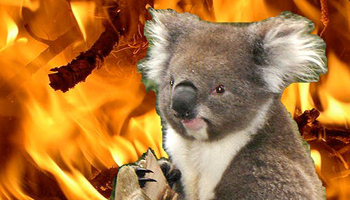Erin Chapman

Recent bushfires in Australia have killed more than 180 people, destroyed over 1,800 houses and left about 7,000 people homeless. Not to mention the burned paws. (Poor koalas! First the plague of chlamydia and now the raging fires. Apparently they’ve done something to draw down a biblical-type wrath upon their species.)
But fire isn’t just a problem in the Land Down Under. In the last two years, devastating infernos have ravaged California, Spain and Greece. What’s going on? Will no one heed Smokey Bear’s message? Is he merely a woodland Cassandra, his dire prophecies falling on unheeding ears?
There actually seem to be two main reasons bushfires have become such a problem in recent times: more people are building in fire-prone areas, and the earth is suffering the effects of climate change. In Australia, as in California, land use patterns are changing as farms and timberland give way to cityfolk looking for weekend getaway homes. Urban sprawl is also fanning the flames by bringing the borders of cities dangerously close to brush land. As for climate change — Australia is the driest inhabited continent, making it especially susceptible to global warming. In 2007, Nobel Prize winners and crystal ball owners, the Intergovernmental Panel on Climate Change, said that fires in Australia were “virtually certain to increase in intensity and frequency.”
Bushfires in Australia are nothing new. The fossil record has evidence of charred eucalyptus trees dating back millions of years. The Aborigines have apparently long known the benefits of controlled burning to prevent larger, unmanageable blazes. It wasn’t really until Europeans arrived in the late 1700s that fires became such a problem. Smallpox blankets, enslavement and uncontrollable flames! Raise your hand if you can’t wait to host 18th century Europeans in YOUR town! When the settlers established their towns and cities, they “discouraged” the practice of controlled burning and so when fires did ignite they were much more intense.
Arson is one of the suspected causes of the latest bushfires in Australia, but they can also be sparked by lightning strikes, the heat of the sun and simple human carelessness. I suppose it’s also possible a kangaroo fell asleep with a cigarette, but I’m doubtful. They’re usually more careful.
In order to ignite and keep burning, fires need three essential components to survive. In the tradition of the Nutrition Pyramid and the Punnett Square, scientists working diligently with an innovative team of graphic designers have come up with their very own polygon to outline these elements – the fire trangle.
- Heat – This one may seem like a no brainer, but a heat source is necessary to spark and maintain fire. Heat evaporates moisture from the fuel (e.g. wood, grass, overturned cars after a Phillies victory), enabling the fire to ignite and spread.
- Fuel – How big and how fast a bushfire is depends in part on what feeds it. The amount of flammable material surrounding a fire is called a “fuel load.” If an area has a large fuel load, the harder, better, faster, and stronger the fire burns. If the fuel is dry, it will catch alight all the quicker.
- Oxygen – The air we breathe contains about 21% oxygen. Fire, though, in yet another hot-dogging example of its superiority, only needs about 16% oxygen to burn. As the fuel burns it reacts with the surrounding air to release heat and produce smoke.
Once a fire has begun, it can be difficult to predict its behavior. Weather is one of the most variable factors when trying to bring flames under control. Strong winds can push flames toward new areas and dry out fuel before the fire reaches it. Since wildfires are able to generate their own wind, they can be self-perpetuating. As the air above the fire is heated it rises and fresh, oxygen-rich air rushes in to take its place. The winds from large fires can be strong enough to hurl burning logs over long distances. High temperatures and low humidity are also catalysts for a more intense burn. Finally, the actual shape of the land influences how quickly bushfires progress. Because hot air rises, fire actually travels uphill faster than down.
But how to stop it? Firefighters try to suppress or eliminate one or more of the fire triangle’s elements. The most basic method is to dig a firebreak in the path of the fire, thus depriving it of fuel. One resident in Victoria (the Australian state where the bushfires raged) was fined over $30,000 (USD) in 2002 for bulldozing trees around his home to create his own firebreak. Ironically, his is the only house left standing in the area. Other methods of controlling the flames include dousing the blaze with water and/or retardants that interrupt the chemical reactions of the fire. The water containers that are slung below helicopters are called Bambi Buckets. Too bad there wasn’t a Bambi’s Mom Bulletproof Vest.
Controlling bushfires is hard work and the average firefighter salary in the U.S. is just over $40,000. Maybe now that George W is retired, we can loan him out to Australia to clear some brush.
(The Australian, Phil Cheney – Grasslands, Christian Science Monitor, National Interagency Fire Center, New Zealand Herald, Smokeybear.com)
